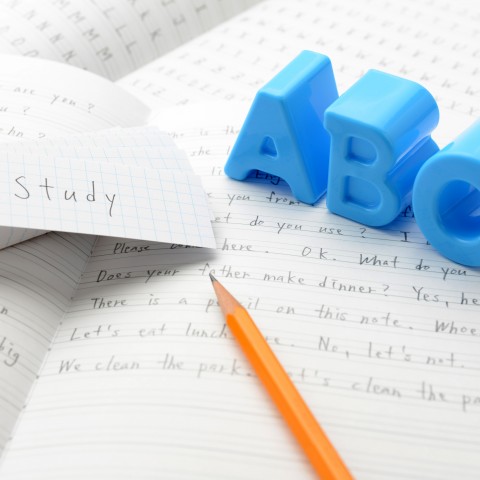
There are over 10,000 Cantonese characters. Considering the vast number of ways these characters can be combined, it would be an understatement to say that this language has a lot of words!
- → If you want to learn more about Cantonese characters and the language’s writing system, visit our guide on CantoneseClass101.com.

Feeling overwhelmed? Keep in mind that even native Cantonese speakers only know a fraction of these words! To start having conversations, you’ll only need a few hundred basic Cantonese words.
In this article, we’ll list the most useful Cantonese words for beginners. Knowing these words will allow you to handle many everyday situations, whether you want to talk, listen, or both. Keep reading!
 Table of Contents
Table of Contents
- Pronouns
- Numbers
- Nouns
- Verbs
- Adjectives
- Conjunctions
- Bonus: Cantonese Final Particles
- How CantoneseClass101.com Can Help You Learn More Cantonese
1. Pronouns
Let’s start with a list of pronouns you should learn as a beginner.
We’ve listed below the basic personal, demonstrative, and interrogative pronouns. As you continue forward in your studies, you’ll be adding a few more to your arsenal.
- → To learn all about Cantonese pronouns and how to use them in a sentence, make sure to visit our complete guide!

Personal Pronouns
| # | Chinese Characters | Romanization | Meaning |
Singular: | |||
| 1 | 我 | ngo5 | I |
| 2 | 你 | nei5 | you |
| 3 | 佢 | keoi5 | he / she / it *There are no differences between “he,” “she,” or “it” in Cantonese. You can use 佢 in each case. |
| 4 | 我嘅 | ngo5 ge3 | my / mine |
| 5 | 你嘅 | nei5 ge3 | your / yours |
| 6 | 佢嘅 | keoi5 ge3 | his / her / hers / its |
Plural: | |||
| 7 | 我哋 | ngo5 dei6 | we / us |
| 8 | 你哋 | nei5 dei6 | you guys |
| 9 | 佢哋 | keoi5 dei6 | they / them |
| 10 | 我哋嘅 | ngo5 dei6 ge3 | our / ours |
| 11 | 你哋嘅 | nei5 dei6 ge3 | your / yours |
| 12 | 佢哋嘅 | keoi5 dei6 ge3 | their / theirs |
Demonstrative Pronouns
| # | Chinese Characters | Romanization | Meaning |
| 1 | 呢個 | ni1 go3 | this |
| 2 | 嗰個 | go2 go3 | that |
| 3 | 呢啲 | ni1 di1 | these |
| 4 | 嗰啲 | go2 di1 |
Interrogative Pronouns
| # | Chinese Characters | Romanization | Meaning |
| 1 | 乜嘢 | mat1 je5 | what |
| 2 | 邊個 | bin1 go3 | who |
| 3 | 邊個嘅 | bin1 go3 ge3 | whose |
| 4 | 幾時 | gei2 si4 | when |
| 5 | 邊度 | bin1 dou6 | where |
| 6 | 點樣 | dim2 joeng2 | how |
| 7 | 點解 | dim2 gaai2 | why |
2. Numbers
As a beginner, you should be able to get by using the numbers one through ten.
- → Should you need more digits, you could check out our article on Cantonese numbers. There, you’ll find everything you need to count from 1-100 and beyond!

- 1: 一 (jat1)
- 2: 二 (ji6)
- 3: 三 (saam1)
- 4: 四 (sei3)
- 5: 五 (ng5)
- 6: 六 (luk6)
- 7: 七 (cat1)
- 8: 八 (baat3)
- 9: 九 (gau2)
- 10: 十 (sap6)
3. Nouns
Nouns are vital in our everyday conversations and we need them for effective communication. Without them, we wouldn’t be able to talk about people, objects, places, or ideas.
Below, you’ll find several basic Cantonese nouns divided into categories.
- → The more Cantonese nouns you know, the closer you’ll be to mastering the Cantonese language! If you want to learn more nouns, check out our top 100 Cantonese nouns list!

Time
| # | Chinese Characters | Romanization | Meaning |
| 1 | 星期 | sing1 kei4 | week |
| 2 | 年 | nin4 | year |
| 3 | 今日 | gam1 jat6 | today |
| 4 | 聽日 | ting1 jat6 | tomorrow |
| 5 | 噚日 | cam4 jat6 | yesterday |
| 6 | 日曆 | jat6 lik6 | calendar |
| 7 | 秒 | miu5 | second |
| 8 | 鐘 | zung1 | hour |
| 9 | 分鐘 | fan1 zung1 | minute |
| 10 | 點 | dim2 | o’clock |
People
| # | Chinese Characters | Romanization | Meaning |
| 1 | 媽媽 | maa4 maa1 | mother |
| 2 | 爸爸 | baa4 baa1 | father |
| 3 | 老婆 | lou5 po4 | wife |
| 4 | 老公 | lou5 gung1 | husband |
| 5 | 女 | neoi2 | daughter |
| 6 | 仔 | zai2 | son |
| 7 | 醫生 | ji1 sang1 | doctor |
| 8 | 律師 | leot6 si1 | lawyer |
| 9 | 護士 | wu6 si6 | nurse |
| 10 | 經理 | ging1 lei5 | manager |
Places Around Town
| # | Chinese Characters | Romanization | Meaning |
| 1 | 便利店 | bin6 lei6 dim3 | convenience store |
| 2 | 藥房 | joek6 fong4 | drugstore |
| 3 | 商場 | soeng1 coeng4 | shopping mall |
| 4 | 超市 | ciu1 si5 | supermarket |
| 5 | 咖啡室 | gaa3 fe1 sat1 | coffee shop / cafe |
| 6 | 山頂 | saan1 deng2 | The Peak |
| 7 | 維港 | wai4 gong2 | Victoria Harbor |
| 8 | 星光大道 | sing1 gwong1 daai6 dou6 | Avenue of Stars |
| 9 | 海洋公園 | hoi2 joeng4 gung1 jyun2 | Ocean Park |
| 10 | 天壇大佛 | tin1 taan4 daai6 fat6 | Tian Tan Buddha |
School/Office Essentials
| # | Chinese Characters | Romanization | Meaning |
| 1 | 作業 | zok3 jip6 | homework |
| 2 | 筆記簿 | bat1 gei3 bou2 | notebook |
| 3 | 同學 | tung4 hok6 | classmate |
| 4 | 大學 | daai6 hok6 | university |
| 5 | 背囊 | bui3 nong4 | backpack |
| 6 | 鉛筆 | jyun4 bat1 | pencil |
| 7 | 原子筆 | jyun4 zi2 bat1 | pen |
| 8 | 數學 | sou3 hok6 | math |
| 9 | 考試 | haau2 si3 | exam |
| 10 | 學生 | hok6 saang1 | student |
Body Parts
| # | Chinese Characters | Romanization | Meaning |
| 1 | 腳 | goek3 | foot |
| 2 | 腿 | teoi2 | leg |
| 3 | 頭 | tau4 | head |
| 4 | 手臂 | sau2 bei3 | arm |
| 5 | 手 | sau2 | hand |
| 6 | 手指 | sau2 zi2 | finger |
| 7 | 身體 | san1 tai2 | body |
| 8 | 肚 | tou5 | stomach |
| 9 | 背脊 | bui3 zek3 | back |
| 10 | 胸 | hung1 | chest |
Food
| # | Chinese Characters | Romanization | Meaning |
| 1 | 水果 | seoi2 gwo2 | fruit |
| 2 | 蘋果 | ping4 gwo2 | apple |
| 3 | 香蕉 | hoeng1 ziu1 | banana |
| 4 | 西瓜 | sai1 gwaa1 | watermelon |
| 5 | 提子 | tai4 zi2 | grape |
| 6 | 菠蘿 | bo1 lo4 | pineapple |
| 7 | 蜜瓜 | mat6 gwaa1 | melon |
| 8 | 西柚 | sai1 jau2 | grapefruit |
| 9 | 蔬菜 | so1 coi3 | vegetable |
| 10 | 薯仔 | syu4 zai2 | potato |
| 11 | 粟米 | suk1 mai5 | corn |
| 12 | 大豆 | daai6 dau2 | soybean |
| 13 | 蕃薯 | faan1 syu2 | sweet potato |
| 14 | 紅蘿蔔 | hung4 lo4 baak6 | carrot |
| 15 | 洋葱 | joeng4 cung1 | onion |
| 16 | 胡椒 | wu4 ziu1 | peppers |
| 17 | 西蘭花 | sai1 laan4 faa1 | broccoli |
| 18 | 蕃茄 | faan1 ke2 | tomato |
| 19 | 蘑菇 | mo4 gu1 | mushroom |
| 20 | 腰果 | jiu1 gwo2 | cashew nut |
4. Verbs
Below is a list of the 50 most useful Cantonese verbs for beginners. Of course, depending on whether you’re studying, working, or just visiting, you might have different needs. But in any case, this list is a good place to start!
- → For more information on the topic, be sure to have a look at our full article on Cantonese verbs.

| # | Chinese Characters | Romanization | Meaning |
| 1 | 去 | heoi3 | go |
| 2 | 食 | sik6 | eat |
| 3 | 飲 | jam2 | drink |
| 4 | 行 | haan4 | walk |
| 5 | 明 | ming4 | understand |
| 6 | 諗 | lam2 | think |
| 7 | 瞓覺 | fan3 gaau3 | sleep |
| 8 | 答 | daap3 | answer |
| 9 | 拎 | ling1 | take |
| 10 | 做嘢 | zou6 je5 | work |
| 11 | 講 | gong2 | talk |
| 12 | 睇 | tai2 | watch |
| 13 | 問 | man6 | ask |
| 14 | 跑 | paau2 | run |
| 15 | 聽 | teng1 | hear |
| 16 | 玩 | waan2 | play |
| 17 | 認識 | jing6 sik1 | know |
| 18 | 幫 | bong1 | help |
| 19 | 鍾意 | zung6 ji3 | like |
| 20 | 收 | sau1 | receive |
| 21 | 用 | jung6 | use |
| 22 | 計劃 | gai3 waak6 | plan |
| 23 | 解釋 | gaai2 sik1 | explain |
| 24 | 跳 | tiu3 | jump |
| 25 | 教 | gaau3 | teach |
| 26 | 買 | maai5 | buy |
| 27 | 讀 | duk6 | read |
| 28 | 開始 | hoi1 ci2 | begin |
| 29 | 踢 | tek3 | kick |
| 30 | 賣 | maai6 | sell |
| 31 | 離開 | lei4 hoi1 | leave |
| 32 | 成為 | sing4 wai4 | become |
| 33 | 邀請 | jiu1 cing2 | invite |
| 34 | 寫 | se2 | write |
| 35 | 等 | dang2 | wait |
| 36 | 學 | hok6 | study |
| 37 | 分享 | fan1 hoeng2 | share |
| 38 | 打 | daa2 | call |
| 39 | 記得 | gei3 dak1 | remember |
| 40 | 相信 | soeng1 seon3 | believe |
| 41 | 解決 | gaai2 kyut3 | solve |
| 42 | 介紹 | gaai3 siu6 | introduce |
| 43 | 取消 | ceoi2 siu1 | cancel |
| 44 | 到 | dou3 | arrive |
| 45 | 唱 | coeng3 | sing |
| 46 | 笑 | siu3 | smile |
| 47 | 休息 | jau1 sik1 | rest |
| 48 | 煮 | zyu2 | cook |
| 49 | 覺得 | gok3 dak1 | feel |
| 50 | 畫畫 | waat6 waa2 | draw |
5. Adjectives
Another set of Cantonese beginner words you should study are basic adjectives.
Adjectives are very important in our everyday conversations and in writing. Without them, you wouldn’t be able to describe how pretty the girl sitting next to you is or how spectacular the scenery is.
- → If you want to put more Cantonese adjectives in your pocket, make sure to check out our complete guide on Cantonese adjectives.

Describing Objects
| # | Chinese Characters | Romanization | Meaning |
| 1 | 高 | gou1 | tall |
| 2 | 短 | dyun2 | short |
| 3 | 大 | daai6 | big / huge |
| 4 | 闊 | fut3 | wide |
| 5 | 長 | coeng4 | long |
| 6 | 厚 | hau5 | thick |
| 7 | 細 | sai3 | small / little |
| 8 | 瘦 | sau3 | thin |
| 9 | 深 | sam1 | deep |
| 10 | 窄 | zaak3 | narrow |
Describing People
| # | Chinese Characters | Romanization | Meaning |
| 1 | 勤力 | kan4 lik6 | diligent |
| 2 | 幽默 | jau1 mak6 | humorous |
| 3 | 誠實 | sing4 sat6 | honest |
| 4 | 有趣 | jau5 ceoi3 | funny |
| 5 | 冷靜 | laang5 zing6 | calm |
| 6 | 怕醜 | paa3 cau2 | shy |
| 7 | 善良 | sin6 loeng4 | kind |
| 8 | 有活力 | jau5 wut6 lik6 | energetic |
| 9 | 親切 | can1 cit3 | friendly |
| 10 | 聰明 | cung1 ming4 | smart |
Describing Emotions
| # | Chinese Characters | Romanization | Meaning |
| 1 | 不安 | bat1 on1 | anxious |
| 2 | 驕傲 | giu1 ou6 | proud |
| 3 | 攰 | gui6 | tired |
| 4 | 肚餓 | tou5 ngo6 | hungry |
| 5 | 飽 | baau2 | full |
| 6 | 開心 | hoi1 sam1 | happy |
| 7 | 傷心 | soeng1 sam1 | sad |
| 8 | 悶 | mun6 | bored |
| 9 | 嬲 | nau1 | angry |
| 10 | 興奮 | hing1 fan5 | excited |
Describing Weather
| # | Chinese Characters | Romanization | Meaning |
| 1 | 凍 | dung3 | cold |
| 2 | 熱 | jit6 | hot |
| 3 | 溫暖 | wan1 nyun5 | warm |
| 4 | 潮濕 | ciu4 sap1 | humid |
| 5 | 曬 | saai3 | sunny |
| 6 | 有風 | jau5 fung1 | windy |
| 7 | 天晴 | tin1 cing4 | sunny |
| 8 | 密雲 | mat6 wan4 | cloudy |
6. Conjunctions
There’s a lot to say and explain when it comes to Cantonese conjunctions, but luckily, you don’t need many when you first start learning Cantonese.
→ As you progress in your studies, you might want to have a look at our complete guide on Cantonese conjunctions. You’ll learn everything about how to connect phrases, express conditions, talk about consequences, and much more.
| # | Chinese Characters | Romanization | Meaning |
| 1 | 和 | wo4 | and |
| 2 | 或者 | waak6 ze2 | or |
| 3 | 即使 | zik1 si2 | even if |
| 4 | 因為 | jan1 wai6 | since |
| 5 | 於是 | jyu1 si6 | so |
| 6 | 但係 | daan6 hai6 | but |
| 7 | 除非 | ceoi4 fei1 | unless |
| 8 | 而且 | ji4 ce2 | also |
| 9 | 雖然 | seoi1 jin4 | although |
| 10 | 如果 | jyu4 gwo2 | if |
7. Bonus: Cantonese Final Particles
In Cantonese we have a special type of word called final particles. Final particles are meaningless by themselves, but when placed at the end of a sentence, they indicate the mood or attitude of the speaker. They also serve to make speech more colloquial. Here are the top five Cantonese final particles:
| # | Chinese Characters | Romanization | Function |
| 1 | 呀 | aa3 | Indicates enthusiasm and friendliness (usually in a softer tone); can also be used as a sarcastic retort |
| 2 | 喇 | laa3 | Indicates an exclamation with an emphasis on the past; “already” |
| 3 | 嘅 | ge3 | Indicates humbleness or understanding; emphasis on raising the fact in a subtle way |
| 4 | 㗎 | gaa3 | Emphasizes a fact that’s being raised |
| 5 | 囉 | lo1 | Indicates discontentment or sarcasm |
- → Intrigued by how useful these “meaningless” final particles can be? Have a look at our full article here to see what other Cantonese final particles there are!
8. How CantoneseClass101.com Can Help You Learn More Cantonese
Ready to move on to the next level after learning all of these Cantonese beginner words? We recommend starting with our series of Cantonese beginner lessons:
With CantoneseClass101.com, you can have your daily dose of Cantonese whenever and wherever you want, through mobile apps, desktop software, and our website. We offer entertaining, engaging, and effective lessons on various aspects of the Cantonese language and culture.
Until now, we’ve delivered more than 750,000,000 lessons to thousands of happy students from all around the globe. You can learn Cantonese with over 1060 audio and video lessons delivered by our knowledgeable and energetic hosts, detailed PDF lesson notes, an abundance of vocabulary learning tools, spaced repetition flashcards, and a lively community where you can discuss lessons with fellow learners. What are you waiting for? Download our lessons, enjoy our audio and video files, and start learning now!
Keep in mind that if you prefer a 1-on-1 learning approach and want to further accelerate your Cantonese learning, you can take advantage of our MyTeacher program!
Know that your hard work will pay off, and before you know it, you’ll be speaking Cantonese like a native!
Before you go: How many of these words did you know already? Were most of them new to you? We look forward to hearing from you in the comments!










